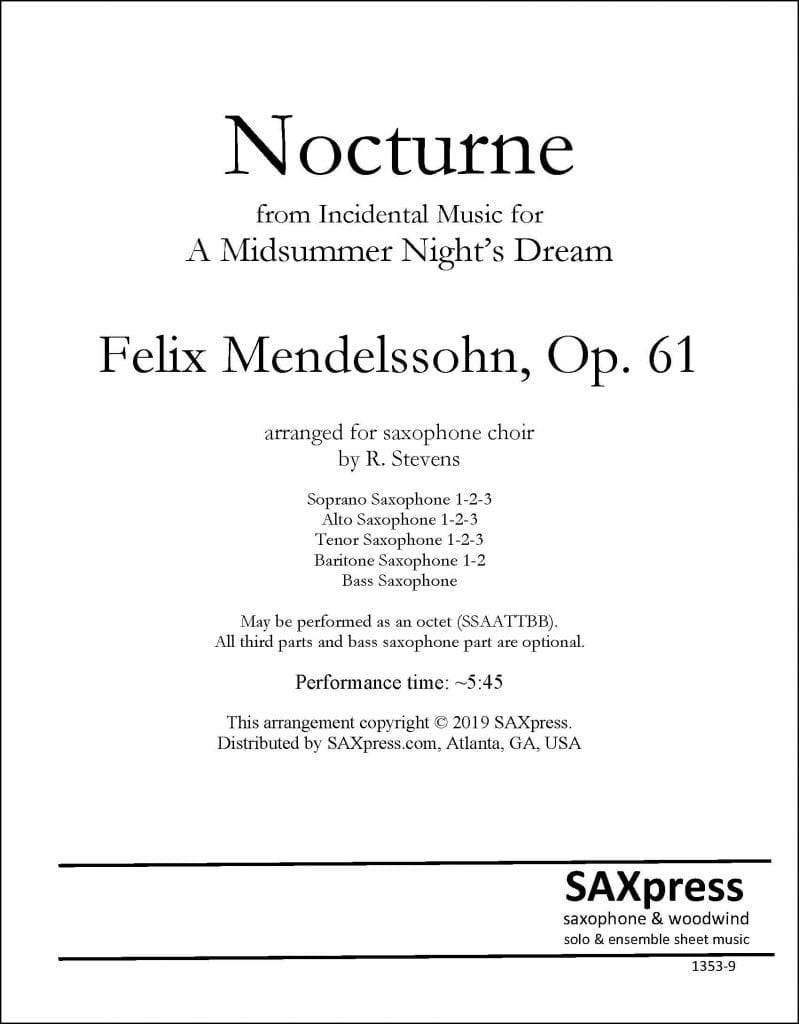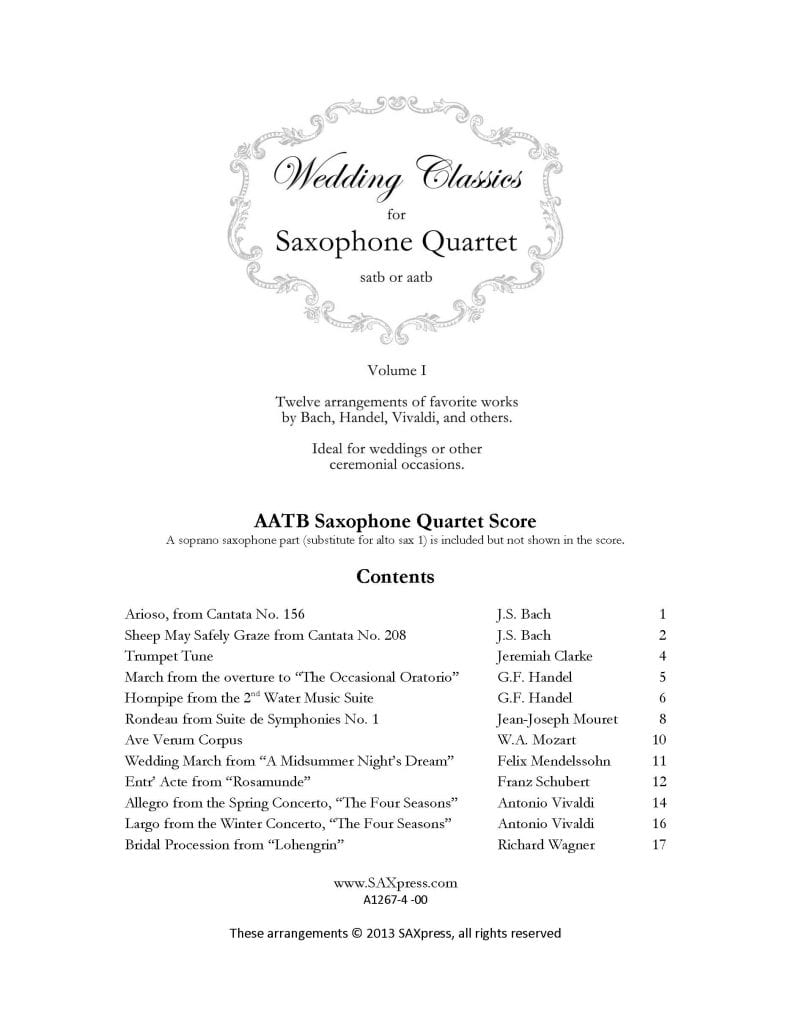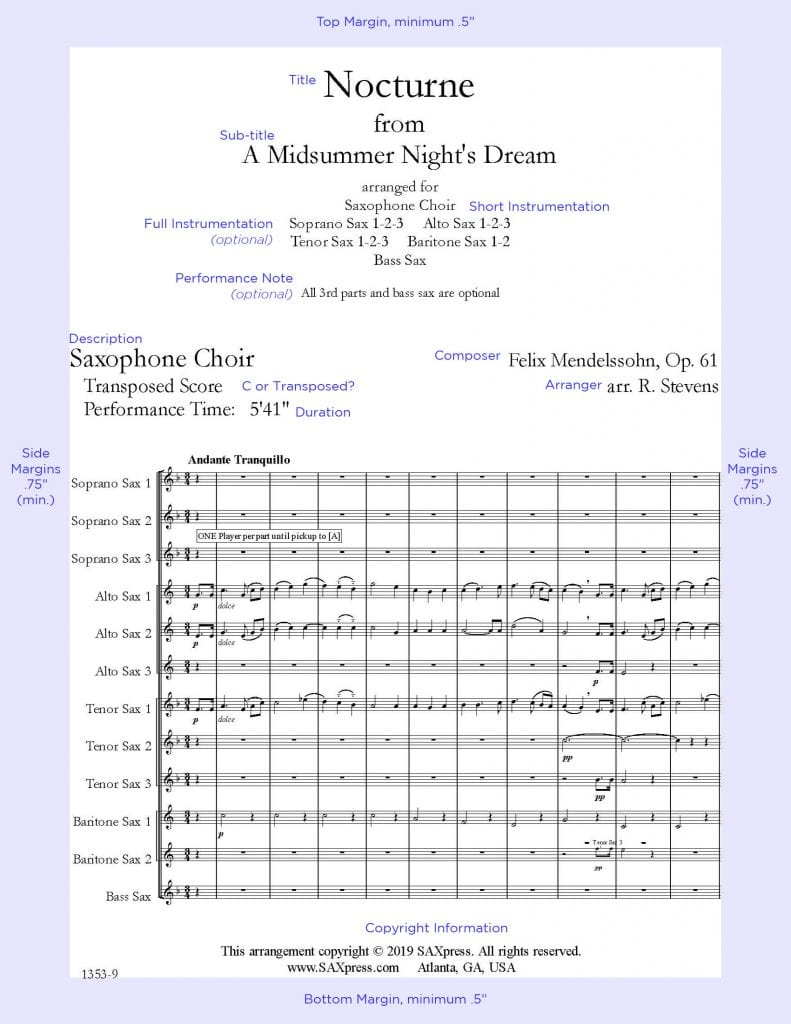SUBMIT YOUR WORK
for publication by SAXpress
Submit Your Arrangements or Compositions for Publication
You are welcome to submit your arrangements or compositions for publication consideration. Just follow the guidelines below, fill out the form, and upload your files. A few thoughts before you send anything:
-
- Browse our current inventory to see if your music is a good fit for SAXpress.
- Currently we only accept solo and ensemble music for saxophones or woodwinds. At this time we do not accept music for brass ensembles, full wind ensemble, or orchestra.
- Please send your arrangement to one publisher at a time. (If your arrangement is already at another publisher for consideration, wait until you hear from them before sending it to us).
Follow these steps to submit your work for publication
-
- Make an account on SAXpress.com.
- Review our Music Preparation Guidelines. Make sure your scores and parts are well laid out.
- Have these files ready to submit along with your form:
-
- ZIP File including separate PDF files for the score and each part. You may upload the PDF files individually.
You may include the Finale .musx file instead of PDF files.
- MP3 audio file of your piece. If you have quality recording of a live performance, that is preferred to a digitally generated version. If you have no recording, you must submit the Finale .musx file or a music XML file so a digital audio file of your piece may be generated.
- ZIP File including separate PDF files for the score and each part. You may upload the PDF files individually.
-
Fill out the Submit for Review form here
We try to review submissions in a timely manner. At times, however, it may take up to 4-6 weeks for the review process. Thank you for your patience.
If your piece is accepted for publication, be sure to have a valid PayPal account ready to receive commission payments. See “Royalties and Payments” section below.
Music
Preparation
Guidelines
General Comments
Sheet music must be properly formatted and clearly legible. Badly formatted scores or parts will not be published or distributed. Please review and follow these music preparation guidelines when formatting your scores and parts.
- All scores and parts must be in portrait orientation. Landscape oriented parts or scores will be rejected.
- Scores must be computer engraved, i.e. no scans of handwritten sheet music.
- Each measure (bar) should be numbered at the beginning of each staff system, beginning again with each movement if in a multi-movement work.
- Rehearsal letters should correspond to musical landmarks and must be used in conjunction with—not instead of—measure numbers.
- Avoid the use of the abbreviations 8va and 8vb. They are sometimes acceptable in C scores to save space, almost never in parts, except for piano or other keyboard parts.
If you submit music in a non-standard or poorly formatted form, it will be rejected. If you require help with formatting your work for publication, SAXpress can provide engraving/typesetting assistance but your royalty percentage will be greatly reduced to offset our standard hourly rate ($55.00) for music engraving (email for details).
Cover, Title, and Notes Pages
Cover Page (front and back)
SAXpress creates covers based on information from your sheet music. If you include cover pages they will not be used.
Title Page
OPTIONAL – we can create this if needed
Not always used but if included, then the following information needs to be listed:
- Title
- Composer
- Arranger
- Lyricist (if applicable)
- Short instrumentation (e.g. for Orchestra)
- Full instrumentation including doublings and all instruments
- Duration
- Description (e.g. TRANSPOSED SCORE, C SCORE, or Flute I)
- Note that title pages are generally only used for scores
Notes page(s)
OPTIONAL – we can create this if needed
Not always used but if included, then the following information needs to be listed:
- Full title of work, printed as it would appear in a formal concert program, including appropriate capitalization and diacritical markings, along with movement titles in their proper order.
- Full instrumentation including doublings and all instruments
- Duration
- Commissioning credit
- First performance
- Program Notes (recommended)
- Describe any deviations from standard musical notation.
- Describe any specific staging instructions. Detailed diagrams are helpful to illustrate particularly complex staging.
- Describe any special equipment, or other technical requirements (also note these details on a cover page in the instrument’s part). Instructions should be as specific and as understandable as possible.
- Include any special instructions for “prepared instruments” or other uncommon instruments. (also note these details on the cover page of the instrument’s part).
For smaller scores with no specific performance indications it is possible to combine the Title page and Notes page.

Table of Contents
SOMETIMES REQUIRED
If your submission is a collection of short pieces (not a multi-movement work), a table of contents must be included in the score. If parts for those collections have cover pages, it should be included there as well.
Add additional blank pages to your score or parts as needed for proper pagination or page turns.

First Music Page of Score
The following items must be displayed on the first music page of your score, in a reasonably standardized format.
- Title
- Movement title or Subtitle, if applicable
- Composer
- Arranger
- Year composed (optional)
- Duration (usually on score only)
- Transposed or C score
- Lyricist (if applicable)
- Short instrumentation (e.g. for Orchestra)
- Description (e.g. (FULL SCORE, or Flute I)
- Copyright Information, e.g. Copyright © 2018 Bob A. Hack (ASCAP or BMI)

Page Sizes, Orientation, Margins, Layout, etc
Page Sizes, Orientation, Margins, Etc.
Visit this site for detailed explanations for international paper sizes.
SAXpress accepts parts and scores with the following page sizes:
- 8.5 x 11″ (US Letter size)
- 9 x 12″ (UK/EU paper size C4)
If you submit a work for a very large ensemble, Legal (8.5 x 14.0”) or Tabloid (11.0 x 17.0 in) is acceptable for the score but parts must be 9” x 12″ or 8.5” x 11”. Often, a condensed or semi-condensed score will solve the problem of an over-large score.
All pages must be in portrait orientation. Scores or parts in landscape orientation will be rejected unless there’s an awfully good reason.
Full Scores
- Score size: 8.5 x 11″ or 9 x 12″, portrait orientation.
- Staff size 4 mm. to 6 mm.
- Margins: sides .75” (1.905 cm); top and bottom .5” (1.27 cm) (listed margin sizes are minimums and may be increased -within reason- for spacing and legibility). Inside margin should be increased to allow for spiral binding for large scores.
- First page of music (scores and parts) should have a copyright notice centered on the bottom of the page.
- All tempo indications should appear above the top staff on each score page.
- Instrumental scores may be optimized (empty staves removed) to save space, and to fit more systems per page.
- C scores and transposed scores are both acceptable, each has advantages and disadvantages. Whether it’s a C score or transposed, you need to indicate that on the first page (usually upper left-hand corner).
- Scores may have more than one instrument per staff – parts, NEVER.
Piano Scores
- Short works (8 pages or less) with piano accompaniment may be on 8.5 x 11″ but longer works should be formatted 9 x 12” (UK/EU B4), 7 mm. staff, always in portrait orientation.
- Margins: sides .75”; top and bottom .5”
- Solo instrument(s) with piano: make the solo instrument staves 60% of the standard size (7 mm.).
Parts
- 8.5 x 11″ or 9 x 12″, portrait orientation. 7 mm. staff.
- Margins: sides .75”; top and bottom .5” (listed margin sizes are minimums and may be increased -within reason- for spacing and legibility).
- The first page of each part must have the instrument name.
- All subsequent pages must have a small header at the top indicating the composer, title, and instrument name. Please don’t forget to do this. An example header: Haydn, Quartet Op. 76, No. 1, Soprano Saxophone
- All odd-numbered (right-hand) pages must have reasonable page turns. It is more acceptable to have half a page of empty space than an impossible page turn. There is always a way.
- Pay careful attention to the placement of page turns; build blank pages into the parts to facilitate turns. Each blank page should include a phrase such as “Blank Page for Page Turn” to indicate that the blank page isn’t a missing page of music.
- If a part begins on page 2 (for page turns) please include a title page as page 1.
- In some cases foldouts or tri-fold pages are acceptable, but only as a last resort.
- In larger works, logical cue notes are welcome during long periods of rest, the cues being transposed to the reading key of the instrument. Generally, if there are 16 or more measures of rest for bars with the same meter you should probably add a cue.
- Tempo and meter changes must be shown on all parts, even during periods of extended rest.
Page Numbering, Measure Numbering, and Rehearsal Letters
Page Numbering
- Odd-numbered pages on the right. Even-numbered pages on the left. There are never any exceptions to this rule.
- In music, we do not count the front matter (pages before the music starts). The first page of music is page 1, and the rest of the book should continue sequentially. The convention is to put page numbers in the top “outside” corners; odd numbers on the right, even numbers on the left.
- If you have a large number of pages in the front matter (e.g., more than 4-6 pp.), they are numbered with lower-case roman numerals, centered at the bottom of the page.
- The first page number is never shown (e.g., page 1 or page i)
Measure Numbering and Rehearsal Letters
- Measure numbers should be indicated at the start of every system, at the top, at a point size that’s readable. Do not number number every 5 or 10 bars.
- Numbering each measure should be avoided.
- Measure number ranges indicated below multi-measure rests are very helpful.
- Rehearsal letters must be used for large scores and longer works.
- Rehearsal letters should be placed according to musical landmarks, not at every set interval.
- In multi-movement works, measure numbers should begin at 1 in each movement whereas Rehearsal letters may continue in sequence from movement to movement.
Typefaces
Typefaces
The following comments are only guidelines. In all matters, clarity takes precedence. Remember, people are used to their sheet music “reading” a certain way.
- There are two basic styles of fonts used for music text—page numbers, headers, front matter, technical indications, etc.: serif (i.e., Times New Roman, Plantin, Times, Garamond, Goudy, or Caslon, etc.), or sans serif (i.e., Helvetica, Futura, Optima, Gill Sans, etc.). Serif fonts are generally more common. Whichever font you use, that same font style and family should be used throughout your entire piece; never use both Plantin and Times New Roman, for example. It is always best to use as few fonts as possible, but different styles within a font family (plain, bold, italic, wide or narrow versions of the same font) are perfectly acceptable, when appropriate.
- Tempo indications (above the staff): Times New Roman, bold, 14 pt.
- Tempo alterations (like rit. and accel.): Times New Roman, either italic or bold, 14 pt.
- Title, composer, lyricist. These are usually a serif font, like Times New Roman. Sizes may vary depending on house style, but the default sizes in programs like Sibelius are acceptable.
- Technique text (above the staff): Times New Roman, plain, same font as tempo indications.
- Expression text (below or above the staff): Times New Roman, italic.
Jazz or show tunes may be set in a faux handwritten font such as Broadway Copyist or Finale Copyist IF the resulting pages are legible.
Additional Resources
All suggested resources are in English; books link to Amazon.
Notation Books
- Behind Bars by Elaine Gould
- Music Notation by Gardner Read
- Music Notation in the Twentieth Century by Kurt Stone
Music Software and Plugins
- Sibelius – Music Notation Software
- Finale – Music Notation Software
- Dorico – Music Notation Software
- Musicprep.com – Useful Sibelius Extras
- Finale Tips – Finale Tips and Plugins, including JW plugins
- TG Tools – Comprehensive Plugins for Finale
SAXpress uses Finale to engrave sheet music but there are other viable options out there.
Royalties
&
Payments
Royalties
Sheet music on SAXpress is sold and delivered to customers in three different forms. The commission is slightly different depending on how the customer takes delivery. As production costs on printed matter are higher, the sale prices are higher and the commission is slightly lower. This has the effect of leveling your commission across all three sales types. See the example below.
Download Only
Customer receives a link to download a digital version of their sheet music. Customer is responsible for printing their sheet music
Print Only
Customer receives their printed sheet music by mail. There is no download file.
Download and Print
Customer receives a link to download a digital version of their sheet music and a printed copy of their sheet music by mail.
The following example shows typical pricing for a moderate length quartet with no alternate parts and the commission you would receive based on a single sale.
| Delivery Method | Sale Price | Commission Percentage | Your Payment |
| Download Only | 12.95 | 45% | 5.83 |
| Print Only | 14.95 | 40% | 5.98 |
| Download and Print | 16.95 | 35% | 5.93 |
At this time (07/2019) most sales (over 90%) on SAXpress are for Download Only products. This is completely a function of the online marketplace and we have little control over that fact.
Payments
You may choose to have your royalties paid monthly, regardless of the amount or have them held until a threshold is reached.
From time to time we offer sale prices on certain products. Commissions are calculated based on the final sale price of the item after any discounts are applied.
Royalties are paid within 1 month (30 days) of the sale date or within 30 days of reaching the goal amount you select.
Royalties are paid via PayPal at this time. Please be sure that your account is in good standing before you have any sales via SAXpress. If your PayPal account is suspended or otherwise inaccessible and we cannot contact you, royalties will be held for a period 180 days then forfeited.
If you live in an area that is not serviced by PayPal, royalties are paid via Transferwise. To receive funds via Transferwise you must have a bank account they recognize. Please visit Transferwise.com for complete details of receiving funds. Any fees required to transfer funds will be deducted from your commission. If your Transferwise account is suspended or otherwise inaccessible and we cannot contact you, royalties will be held for a period 180 days then forfeited.
Other questions? Send a note or call!
